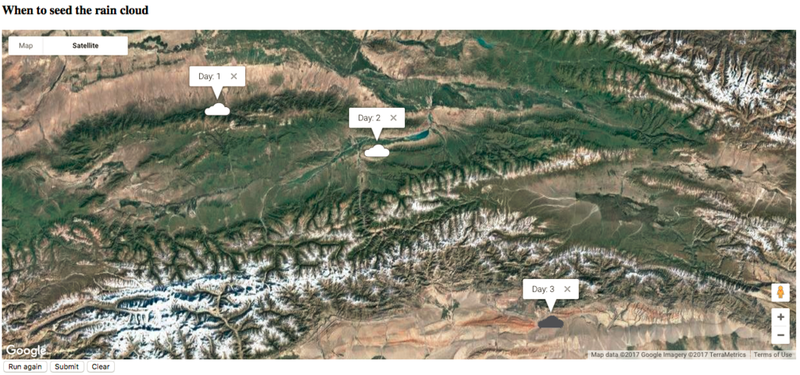Team Moist | Where's the Water?
The Challenge | Where's the Water?
Cloud Seeding Planner
This project uses the grounds moisture level and future precipitation level, to determine the best time to seed a cloud.

Cloud Seeding is a form of weather modification, a way of changing the amount or type of precipitation that falls from a cloud. This is done by dispersing substances into the air that serve as cloud condensation (usually dry ice) which alter the micros-physical processes within the cloud.
This project used the 'Open Weather Map' API. This API, tracks the weather forecast, which includes; the amount of precipitation, cloud coverage, and wind velocity. We used this data to calculate where the clouds will be located. By using the wind velocity, it allowed us to determine the direction in which the clouds will be travelling at a given point in time. Therefore allowing us to give them a location on a certain day.
The location and movement of the clouds is visualised using the 'Google Maps JavaScript' API. We chose this because it is openly available. Due to this, it means that the users who interact with this project will be comfortable with using this tool.
We chose to create a web app that can be hosted on Bluemix as an example server. We added custom markers to attach white cloud logos. When our app's ranking algorithm determines the optimal time for a given cloud to be seeded, a different colour (dark grey) is used as a marker to indicate this newfound state. When an individual cloud marker is selected, it states on which day the cloud will be at that location.
The optimal time to seed a cloud is determined using soil moisture and chance of precipitation in the given trajectory of the cloud. We used the 'GRACE' soil moisture datasets, which were given on the challenge resources. These datasets show the soil moisture until 2016. Unfortunately it does not show the current moisture of the ground, however this is what we would use if we had real-time data available. Once we had the soil moisture we included the chance of precipitation in the upcoming days to create our ranking algorithm.
This ranking algorithm allows us to see which area has less ground moisture and will not have much precipitation. The highest given rank is then suggested as the most in need of precipitation. At that the cloud should be seeded at the location time specified.
Considering the use case of the challenge, and the goals 6.5 and 6.6. Farmers, land owners, and land managers, especially, are able to access the tool quickly. An individual can select a region, usually a Country, to allow them to locate clouds in that area. They can then use the white cloud markers to determine whether the cloud will be travelling over their land. This will allow the individual to decide when it is best to start the process of cloud seeding. It would also improve transboundary cooperation since the tool allows land managers to see if other regions, along the cloud's trajectory, require the precipitation more than them.
SpaceApps is a NASA incubator innovation program.